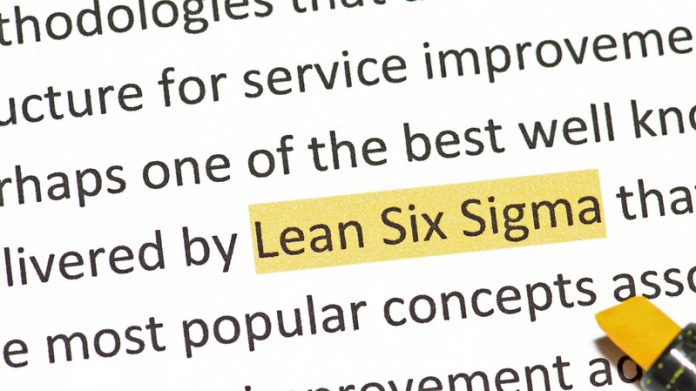Andy Slaney Principal Consultant and Lean Six Sigma Master Black Belt, BSI outlines 10 simple things that working with lean six sigma has taught him…
Although, it can be argued that many of the points below are straight forward, self-evident and simply common sense, because, in fact, they are. It’s equally apparent that in a world where we’re often very busy trying to deliver multiple incremental improvement projects and efficiency gains, that much of what follows is sometimes forgotten or given little consideration.
In organisations where process improvement type work is only given ‘lip service’ and in reality remains low priority or is considered a ‘nice to have’ this deficiency is exacerbated. The desperate struggle to keep ‘continuous improvement’ on the corporate agenda, in any way they can, sometimes overshadowing a systematic and thoughtful way forward for those directly involved in CI programmes.
So here goes, certainly not a comprehensive list of tips, but one that works for me personally and hopefully something you might consider and which may be useful in your future green or black belt projects, lean activities, or problem solving tasks.
1.We all have customers and we all are customers
- Never forget that you have customers (obviously important), but also that you yourself are a customer.
- To succeed in any project, where possible, be clear upfront about what you need from your sponsor, colleagues, process owners, related departments, or other ‘suppliers’, including timescales for when you need their help.
- Always communicate these needs and explain the impact on your project and the organisation should any of your ‘suppliers’ fail. Ensure a ‘no impact, so no problem if I don’t deliver’ mind- set can’t be adopted by those critical to your success.
- Finally, just in case you need one, have a contingency plan if you can.
2. Keep your eyes open to improvement opportunities
- Not always the strategy changing projects you might wish to work on, but you can be sure that small improvements can usually be made everywhere.
- You can also be sure that small improvement opportunities if taken sum to a significantly more capable process long term – ‘the sum of the parts really can be greater than the whole’.
- Certainly given advances in technology, best practice and changing customer needs there’s always a ‘better way’ – so just make sure you’re constantly looking for it.
- Try also to always encourage others to do the same.
3. Everyone’s busy and effort requires a reason
- If you want someone to go the extra mile you need to give them a reason to.
- Clarity of what you want and when you want it needs to be matched by why you want it and the impact it’ll have on stakeholders directly (including those you’re canvassing for help and support).
- If colleagues don’t understand the merits of the destination you’re seeking they won’t join you on the journey. And, certainly won’t carry your pack!
4. Change requires you capture both hearts and minds
- The logic works and it’s common sense to make the change, but you’re still not moving forward? Well, ‘there’s nothing as funny as folk’, or the decisions they sometimes make, as the old Yorkshire expression suggests.
- In a world of competing projects and increasingly finite resources, even great ideas need to be sold, sold hard and sold again (and again!).
- Remember your stakeholders, what ‘makes them tick’ and constantly outline why your idea should be so attractive, specifically to them.
- Think Pareto and have a ‘stakeholder strategy’ to get your idea into the 20 percent perceived as having maximum impact and out from the majority that will never be taken up or explored.
5. A complex analysis requires a simple conclusion
- Your analysis is your journey and your conclusions the destination.
- For business stakeholders, however, no matter how interesting your journey it’s the destination they need to know.
- Conclusions predicate decisions and the simpler these can be the quicker you can get to your goal of a ‘Yes’ (or maybe a ‘No’ if you ignore Point 4).
- Conclusions first, analysis to back you up. Keep it simple and keep your communication priorities in that order.
6. Get an advocate to get ahead
- When the going gets tough even the tough need support and the more powerful your advocates the easier organisational change will be.
- Advocates should include executives, senior management, project champions and sponsors, but also the ‘opinion formers’ found at all levels.
- And if they’re not on your side right now, you need to ask why and what needs to be done to align their views in the way that you need.
- You’ll get to your goal quicker and it will feel so much better once you’ve got the right backing. Work on this early and you’ll avoid ‘project stalls’ and minimise frustration for everyone.
7. Perseverance is to be admired, but only up to a point
- If your point needs proving no matter how much effort and how long it takes, that’s great, but make sure it’s worth it, both to you and your sponsor.
- Persistence is to be admired and is a prerequisite for success, but failure is sometimes inevitable so don’t take it to the grave. Or even into retirement!
- Adapting your passion to alternative projects is essential to ensure long-term success, but this requires a flexibility of your mind-set that involves letting go. Always make sure that you can.
8. Constantly communicate and always seek feedback
- The need to communicate seems self-evident, but make sure it’s two way.
- Lack of feedback can indicate agreement, but equally that your message hasn’t got through at the level you need it to or it may have been ignored.
- Change doesn’t come easily in organisations and the ‘too difficult box’ and ‘long grass’ hide many great concepts dismissed without consideration.
- Always get feedback, good, bad or indifferent.
- If you need to adapt, or put ideas on hold so be it. Delayed plans that need to be modified are better than unevaluated suggestions buried without a trace.
9. Perspective is important and yours is one of many
- If you don’t explore your stakeholder’s views you’ll never understand their motives.
- If you don’t understand their motives you’re unlikely to engender change.
- Context, experience, politics, priorities, targets, self-interest, misunderstandings etc. colour all of our perspectives and often real agendas can stay hidden.
- So know your stakeholders, explore their perspectives and importantly show you care. You may not get the whole truth or range of perspectives, but you’ll get closer if you ask than if you don’t.
- Once you understand stakeholder perspectives you’re in good shape to work on points 4 and 6.
10. Use improvement tools to add value and not just tick boxes
- You’d never use a hammer just because it was in the toolbox so, why do this with business improvement tools, or lean six sigma projects.
- Outside of trial and error (when needed), gaining experience post-training, or demonstrating your grasp of techniques for ‘belt certification’ select only the tools you think or know you’ll require. You’ll be surprised at the quality and speed of progress you can then make.
- Similarly, use DMAIC (six sigma methodology) where it’s warranted and not where it isn’t – if the solution’s blatantly obvious then ‘just go do’.
- Improvement projects and activities need to be robust, but this doesn’t imply a need for great complexity and deep analysis on all occasions.
- Simpler is better and over-processing is a waste – never ‘use a sledgehammer to crack a nut’.
Good luck to all with your improvement initiatives.
Dr Andy Slaney
Principal Consultant and Lean Six Sigma
BSI











